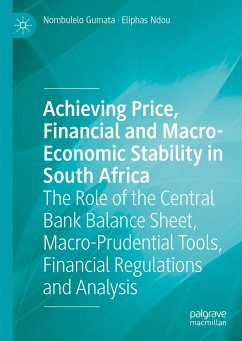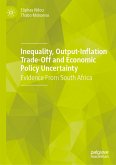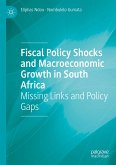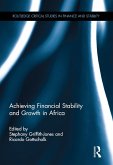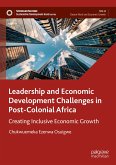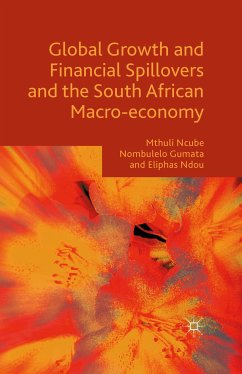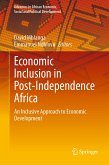Achieving Price, Financial and Macro-Economic Stability in South Africa (eBook, PDF)
The Role of the Central Bank Balance Sheet, Macro-Prudential Tools, Financial Regulations and Analysis


Alle Infos zum eBook verschenken

Achieving Price, Financial and Macro-Economic Stability in South Africa (eBook, PDF)
The Role of the Central Bank Balance Sheet, Macro-Prudential Tools, Financial Regulations and Analysis
- Format: PDF
- Merkliste
- Auf die Merkliste
- Bewerten Bewerten
- Teilen
- Produkt teilen
- Produkterinnerung
- Produkterinnerung

Hier können Sie sich einloggen

Bitte loggen Sie sich zunächst in Ihr Kundenkonto ein oder registrieren Sie sich bei bücher.de, um das eBook-Abo tolino select nutzen zu können.
This book explores the macro-financial effects of central bank balance sheets, macro-prudential tools, and financial regulation in South Africa. How employment can be maximised while keeping inflation low and stable is examined in relation to the structural changes required to alter the composition of South African bank balance sheets. Quantitative methods and approaches are utilised to highlight the impact of suggested policies.
This book aims to outline strategies and policy interventions that can help achieve the National Development Plan in South Africa. It will be of interest to…mehr
- Geräte: PC
- ohne Kopierschutz
- eBook Hilfe
- Größe: 17.88MB
![Inequality, Output-Inflation Trade-Off and Economic Policy Uncertainty (eBook, PDF) Inequality, Output-Inflation Trade-Off and Economic Policy Uncertainty (eBook, PDF)]() Eliphas NdouInequality, Output-Inflation Trade-Off and Economic Policy Uncertainty (eBook, PDF)57,95 €
Eliphas NdouInequality, Output-Inflation Trade-Off and Economic Policy Uncertainty (eBook, PDF)57,95 €![Fiscal Policy Shocks and Macroeconomic Growth in South Africa (eBook, PDF) Fiscal Policy Shocks and Macroeconomic Growth in South Africa (eBook, PDF)]() Eliphas NdouFiscal Policy Shocks and Macroeconomic Growth in South Africa (eBook, PDF)97,95 €
Eliphas NdouFiscal Policy Shocks and Macroeconomic Growth in South Africa (eBook, PDF)97,95 €![Achieving Financial Stability and Growth in Africa (eBook, PDF) Achieving Financial Stability and Growth in Africa (eBook, PDF)]() Achieving Financial Stability and Growth in Africa (eBook, PDF)28,95 €
Achieving Financial Stability and Growth in Africa (eBook, PDF)28,95 €![Leadership and Economic Development Challenges in Post-Colonial Africa (eBook, PDF) Leadership and Economic Development Challenges in Post-Colonial Africa (eBook, PDF)]() Chukwuemeka Ezenwa OsuigweLeadership and Economic Development Challenges in Post-Colonial Africa (eBook, PDF)89,95 €
Chukwuemeka Ezenwa OsuigweLeadership and Economic Development Challenges in Post-Colonial Africa (eBook, PDF)89,95 €![Global Growth and Financial Spillovers and the South African Macro-economy (eBook, PDF) Global Growth and Financial Spillovers and the South African Macro-economy (eBook, PDF)]() Mthuli NcubeGlobal Growth and Financial Spillovers and the South African Macro-economy (eBook, PDF)73,95 €
Mthuli NcubeGlobal Growth and Financial Spillovers and the South African Macro-economy (eBook, PDF)73,95 €![Macro Innovation Dynamics and the Golden Age (eBook, PDF) Macro Innovation Dynamics and the Golden Age (eBook, PDF)]() Paul J. J. WelfensMacro Innovation Dynamics and the Golden Age (eBook, PDF)81,95 €
Paul J. J. WelfensMacro Innovation Dynamics and the Golden Age (eBook, PDF)81,95 €![Economic Inclusion in Post-Independence Africa (eBook, PDF) Economic Inclusion in Post-Independence Africa (eBook, PDF)]() Economic Inclusion in Post-Independence Africa (eBook, PDF)121,95 €
Economic Inclusion in Post-Independence Africa (eBook, PDF)121,95 €- -29%11
-
-
This book aims to outline strategies and policy interventions that can help achieve the National Development Plan in South Africa. It will be of interest to researchers and policymakers working within development economics, African economics, development finance, and financial policy.
Dieser Download kann aus rechtlichen Gründen nur mit Rechnungsadresse in A, B, BG, CY, CZ, D, DK, EW, E, FIN, F, GR, HR, H, IRL, I, LT, L, LR, M, NL, PL, P, R, S, SLO, SK ausgeliefert werden.
- Produktdetails
- Verlag: Springer International Publishing
- Seitenzahl: 556
- Erscheinungstermin: 27. Mai 2021
- Englisch
- ISBN-13: 9783030663407
- Artikelnr.: 61974801
- Verlag: Springer International Publishing
- Seitenzahl: 556
- Erscheinungstermin: 27. Mai 2021
- Englisch
- ISBN-13: 9783030663407
- Artikelnr.: 61974801
- Herstellerkennzeichnung Die Herstellerinformationen sind derzeit nicht verfügbar.
Eliphas Ndou is an economist at the South African Reserve Bank and has authored books in international finance, public finances, monetary, labour, macro and microeconomics, time-series econometrics, banking regulation and macro-prudential policy.
